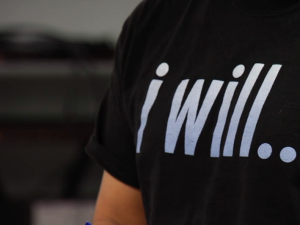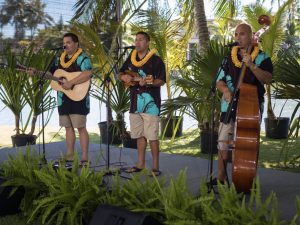Through his Doctoral Defense, Kekuewa Kikiloi explains the reason why Native Hawaiians build temples in the Northwestern Hawaiian Islands.
For the full presentation Click Here
Ma kāna kūpale pepa laeʻula, hōʻike mai ʻo Kekuewa Kikiloi i ke kumu o ko nā ʻōiwi Hawaiʻi kūkulu ʻana i nā heiau ma Papahānaumokuākea. ʻOiai ʻo ia e hoʻohana ana i ka moʻolelo Hawaiʻi a me ka hulikoehana ma ke ʻano he kiʻina hana no kāna noiʻi, alakaʻi mai ʻo ia i nā haumāna o ko Hawaiʻi au hou nei ma kekahi ala hou e noiʻi ai.
I ka mahina nei, ua mālama ʻia kā Kekuewa Kikiloi kūpale pepa laeʻula ma kēia kumuhana hoihoi nō.
Wahi a Kekuewa Kikiloi, Ph.D. ma ke Kālaikanaka ma Ke Kulanui ʻO Hawaiʻi ma Mānoa, “Ma Papahānaumokuākea, ʻo Mokumanamana lāua me Nīhoa, kekahi mau wahi i pohihihi i ke ao no 150 makahiki.”
Koʻakoʻa ʻia me nā koehana o kahiko, he ahuwale ua noho ʻia ʻo Mokumanamana a me Nīhoa e nā kūpuna o ka wā kahiko, ua noho ʻia no kekahi wā lōʻihi i mea e kūkulu ʻia ai i ua mau moku lā. Eia naʻe, ʻo ka nīnau, ʻo ia nō, No ke aha i kūkulu ʻia ai ʻo Mokumanamana lāua me Nīhoa, nā ʻāina pāmalō loa o Hawaiʻi paeʻāina?
Hoʻomau mai ʻo Kekuewa Kikiloi, “I ka wā ma mua, he wahi waiwai hoʻi ʻo Papahānaumokuākea no ka mana naʻi aupuni aliʻi.”
Ua kumu ka mana o nā aliʻi mai ka pō mai, a no ia kumu i
kūkulu ʻia ai nā heiau ma kahi mana nui i nā hōkū a ma kahi i kuhikuhi ʻia e ka ʻoihana kuhikuhipuʻuone, e laʻa me Moku Manamana me Nīhoa. ʻO ia mau moku ʻelua nā moku e waiho nei ma waena konu o ka pō a me ke ao.
“ʻO ia mau moku e hoʻi ana i ka pō, kohu lā ua hōʻunihipili ʻia a akua mai. He hoʻomanaʻo lākou no nā akua i hōʻunihipili ʻia a no ia kumu he mau kumu hoʻohālike lākou no nā aliʻi,” ka ʻōlelo a Kekuewa.
ʻO kekahi o nā moku akua i noiʻi kino ʻia e Kekuewa, ʻo ia nō ʻo Mokumanamana.
“ʻO Mokumanamana ka heiau manamana lima a Wākea. ʻO kona mau hiʻohiʻona, kohu mea lā ʻo ia nā manamana lima ʻākau o Wākea. Hoʻokumu ihola ʻo ia i manaʻo hou no ka lā a mālama ʻia ka ʻaha mua loa. Ma hope iho, ua hele a laha ka ʻaha ma ʻō a ʻō o ka paeʻāina,” ka ʻōlelo a Kekuewa. He mea ka ʻaha e hōʻike ai nā aliʻi i ko lākou mākaukau ma ka hōʻaha ʻana i ka lāhui. He ʻano ea ia e hoʻōla ʻia nei i kēia wā,” ka ʻōlelo a Kekuewa.
ʻOiai ua ahuwale nō ko Kekuewa ʻano loea ma nā ʻano kiʻina e pono ai kēia ʻano noiʻi, ua ʻike ʻia nō, ʻo nā koʻo nui i kākoʻo akula i ua ʻimi loa lā, ʻo ia nō ka ʻōlelo a me ka moʻomeheu Hawaiʻi.
Wahi a Kekuewa, “Aia a heluhelu akula au i ka mana ʻōlelo Hawaiʻi a ʻike ihola au no ka heiau lima. He kōkua nui ka nohona Hawaiʻi ʻoiai nui ke kaona ma nā moʻolelo kuʻuna. ʻAʻole ana maopopo ka poʻe a pau i kēlā ʻano ʻike, eia naʻe, ʻo ka poʻe kūpaʻa ma ka nohona a ʻōlelo Hawaiʻi hoʻi, e ahuwale ana iā lākou.”
I kēia manawa, ua hamama ka ʻīpuka no nā haumāna kūpaʻa ma ka ʻōlelo a moʻomeheu Hawaiʻi, e komo aku ma nā ʻoihana ʻokoʻa o ke au nei, a e hoʻohana i kēia ʻano kaʻinahana noniakahi i mea e huʻe mai ai i ka ʻike hou.
Mea mai ʻo Ben Rudolph Finney, kekahi loea Kālaikanaka me ke kālele ma ka mōʻaukala, “He mea nui kēia, he mea ia e naʻauao ai kākou a pau i kēia ʻano ʻike hou.”
Mea mai ʻo Mehana Hind, “He kōkua nui kāu hana a me ke kaʻinahana āu i hoʻohana ai i nā haumāna o kēia wā. A no laila, mahalo nui iā ʻoe.”
E nānā mai i kā Kekuewa Kikiloi kūpale pepa laeʻula ma ʻŌiwi TV nei.
-na Nāhulu Maioho
Through his Doctoral Defense, Kekuewa Kikiloi explains the reason why Native Hawaiians build temples in the Northwestern Hawaiian Islands. Combining ethno-history (or oral traditions) with archaeology as an integrated method, he paves a new way for method and research for modern Hawaiʻi scholars.
Last month, Kekuewa Kikiloi defended his doctoral research on this intriguing topic.
According to Kekuewa Kikiloi, Ph.D. in Antropology of the University of Hawaiʻi at Mānoa, “The Northwestern Hawaiian Islands, with Mokumanana and Nihoa, represent a mystery that has finally been solved after 150 years of curiosity and wonder.”
These structures that exist on Moku Manamana and Nīhoa show that Hawaiians frequented these islands, but why draw Hawaiians to these uninhabitable islands in the Northwest?
Kekuewa Kikiloi continues, “The Northwestern Hawaiian Islands were important to the sociopolitical development of chiefdoms as this region had cosmological significance.”
Chiefly power was rooted in the spiritual realm. So chiefs built temples in celestially significant locations like Moku Manamana and Nīhoa. The two notably sit between the living and the dead.
“These islands represented the other half of the archipelago… dying islands in the final stages dying and moving into the afterlife, they became deified and god-like. They were a constant reminder of the gods and deified ancestors, whom the chiefs hoped to become after death,” Kekuewa added.
One of the deified islands that Kekuewa has studied is Mokumanamana.
“The island of Mokumanamana was the realization of Wakea’s temple of fingers. Its natural contours and features have an uncanny resemblance to Wakea’s right hand facing upwards with its fingers sticking out of the water. He figuratively gives birth and new meaning to the sun, and also holds the first recorded ‘aha ceremony. Over time the ‘aha ceremony grew in scale and complexity becoming widespread across the islands. It forced them to demonstrate their ability to “braid” people together toward a common purpose, a type of determination and resiliency that is starting to re-emerge today in our Hawaiian people.” Kekuewa said.
Showing a mastery of modern tools and approaches, there is no doubt that his Hawaiian cultural competence drove his research.
According to Kekuewa, “It wasn’t until I read the Hawaiian language version that I read the account of him building the temple of the hand. What I’ve learned as a practitioner has helped a lot. Most, mythology, types of stuff is veiled expressions some people might not be able to see those things so, but I think people that are practitioners that are fluent in Hawaiian language, and are into more ancient type of stuff you’re going to see, the logical continuities in those things.”
This now opens the door for scholars versed in the language and culture to explore other disciplines and use the integrated method to discover new things.
Ben Rudolph Finney an Anthropologist with an expertise in Hawaiian History says, “I want to emphasize what a stupendous study this is, how much this informs us, things we didn’t really have a clue were going on.”
Mehana Hind a cultural practitioner says, “Not only your work but your method and the way you approached what you did, lends a lot to a lot to young scholars and an old scholar like me that hasn’t reached your point yet. And so I thank you for that.
Watch Kekuewa Kikiloi’s entire doctoral defense here on ʻŌiwi TV.
-by Nāhulu Maioho




